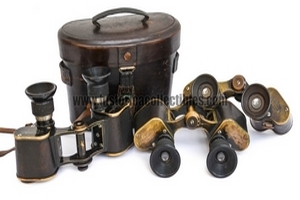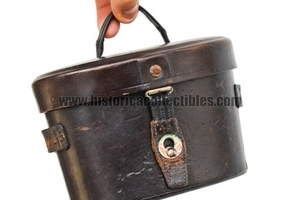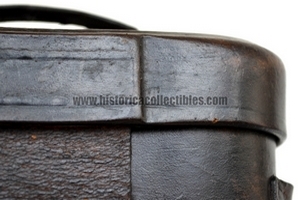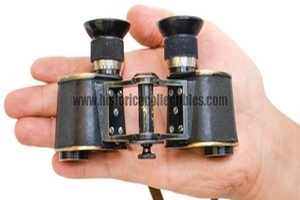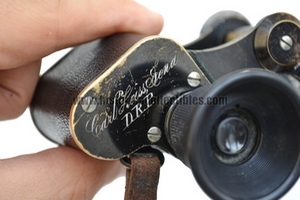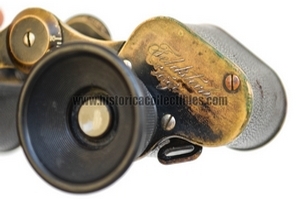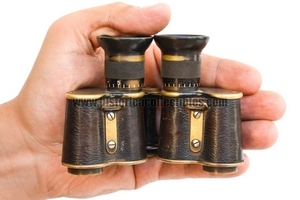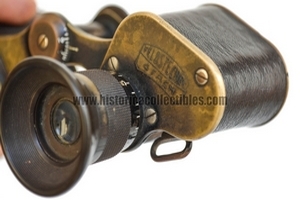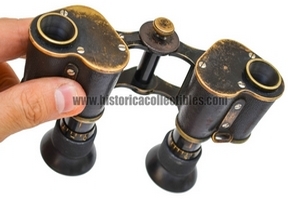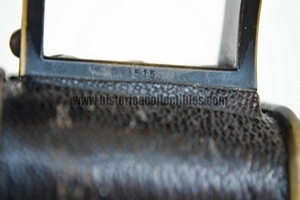3 Feldstecher Mod. 1894 Carl Zeiss Jena, Vergrößerung 4x, circa 1898/1903
3 Feldstechers, produced by Carl Zeiss of Jena between 1898 and 1902, extremely compact and pocket-sized, each equipped with 4 magnifications.
On the left ocular plate are the information relating to the manufacturer "Carl Zeiss Jena and "D.R.P." (Deutsches Reich Patent) or a trademark which indicated that the concession of use of that patent, for the following 15 years, was for exclusive use, in this case, from Zeiss.
The information relating to the magnifications is shown on the right eye plate:
In fact, 2 versions bear "Feldstecher Verg. 4x" and Vergrößerung 4x (Enlargements).
Otherwise, on the third version, it is written "Fach 4x".
The Feldstecher with serial number "967" (produced around 1898) is complete with its original and rare case, with various markings relating to the manufacturer and model of the same, which turns out to be a leather masterpiece due to its compact size and extraordinary finishes. Complete with the very rare "Tommy Bar", housed inside the case, necessary for tightening the chosen interpupillary opening.
The Feldstecher with serial number "1375" was produced around 1901 and is in perfect working order.
The last example, with serial number "3515" (produced around 1903) already bears the characteristic Zeiss logo and has engraved, on the right objective plate, the inscription "R.G. Wehrley Johannesburg & Roodepoort" or an authorized Zeiss dealer active in South Africa, in the city of Johannesburg and in the Roodepoort district.
The vision of each of the 3 binoculars is perfectly sharp, clear and collimated. All mechanisms work perfectly.
Their compact and finely detailed shape makes them small and precious jewels of optical-mechanical engineering.
Carl Zeiss takes its name from its founder, Carl Zeiss, who on November 17, 1846 chose the small city of Jena, in Thuringia, as the location for his precision optical equipment factory. Thanks to the strict quality control that Carl Zeiss imposed on its products, going so far as to personally destroy the microscopes that did not pass the tests, the newborn Zeiss became the official supplier of the University of Jena and received the gold medal of the industrial exhibition in 1861 of Thuringia as the best research instrument manufactured in Germany, awarded to the microscope Stand I of 1857.
In 1866, the thousandth microscope was produced and the Zeiss name became known in all European scientific circles. Thanks to the studies on the Porro prism, in 1893 Abbe patented a double prism binoculars, which accentuated the perception of depth. The mass production of Zeiss binoculars began in 1894, already at the beginning of the twentieth century more than 30,000 were made, by the beginning of the First World War the figure had risen to 500,000 and, by the end of the Second World War, 2,260,000 were produced binoculars for the civilian and military market. Models were made starting from 4x11 mm to 12x40 mm, up to real giants such as 80 mm and 100 mm. Thanks to studies conducted on the perception of light in low light situations, it was shown that the average dilation of the pupil in an adult is about 7 mm.
For this reason, the 7x50 mm model was introduced in 1910 and remained on the market until 1917 with few changes to the materials used. In 1926, following the post-war crisis of the First World War with the Treaty of Versailles which bankrupted many important German companies, Zeiss bought the "C.P. GOERZ" and founded the Zeiss Ikon in 1926. In 1937, Zeiss had commercial contacts and factories spread over 29 countries around the world. From 1933 Zeiss acquired interest from the Nazi regime, which balanced production towards military instruments. It successfully produced binoculars with wide-angle optics for military use, pressure resistant optical systems for U-boats, periscope binoculars for targeting tanks. Furthermore Zeiss cameras were mounted on the V2 for remote sensing operations of the English coasts.
On November 1, 1935, Zeiss, in the person of Alexander Smakula, patented a process for the treatment of optical glasses with extraordinary results in terms of light transmission. Remained a military secret until 1939, it was adopted on binoculars to reduce ghost images and internal reflections. During the Second World War, there were numerous bombings against the Zeiss factories. Jena was bombed several times by the Allies starting in 1944. Stuttgart was razed to the ground, although the Contessa-Nettel factory suffered little damage. The bombing of Dresden, in addition to devastating the city, also caused considerable damage to the Zeiss Ikon headquarters.
On April 13, 1945, American military forces entered Jena, surprising themselves as the bombings had not caused significant damage. The main planetarium was in ruins, while the factories remained operational.

